Anticoccidial Drugs Market Research, 2031
The global anticoccidial drugs market was valued at $171.3 million in 2021, and is projected to reach $257.8 million by 2031, growing at a CAGR of 4.2% from 2022 to 2031. Coccidiosis is a common, and sometimes deadly, intestinal disease caused by a parasitic organism that attaches itself to a chicken’s intestinal lining. This parasitic invasion damages the intestinal tract, preventing the host chicken from absorbing nutrients vital to their survival. It starts with an oocyst, or microscopic egg, that is passed through a chicken’s droppings. The oocyst can lay dormant in soil for up to a year and doesn’t become infectious (sporulate) until the surrounding conditions support its survival. All chickens are carriers of various strains of the coccidiosis organism, but not all become infected with the disease. Coccidiosis can also be spread by unknowingly carrying the eggs (oocysts) of these parasites on clothing or equipment, such as shovels or pails, into the flock environment. The treatment of it usually proceeds for seven days, though sick chickens often show improvement in as little as 24 hours. The best way to handle an outbreak of coccidiosis is to prevent one from occurring in the first place. While these measures won’t always prevent an outbreak, taking these steps can go a long way to ensuring the health of the flock.
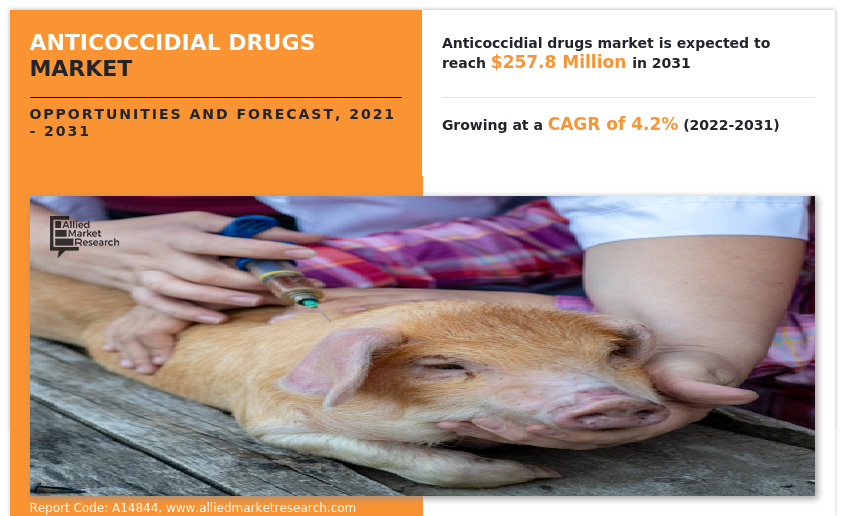
The Anticoccidial Drugs Market Growth is driven by the increase in the development of advanced anticoccidial drugs, and increase in the government initiatives for awareness about coccidiosis and its medications. Moreover, the change in lifestyle and high demand of animal protein food such as meat, milk, and others, increase in the outsourcing of the development of anticoccidial drugs, and the development in the pharmaceutical and biotechnology industries also helps in the growth of the market. However, a stringent government guidelines that restrict the usage of anticoccidial drugs in livestock and the use of alternative medicines such as vaccines and herbal medicines to treat coccidiosis are expected to hinder the growth of this market. Conversely, the rise in awareness about the new products available at affordable rates is expected to create lucrative opportunities for the Anticoccidial Drugs Industry.
The global anticoccidial drugs market is segmented based on drug class, drug action, animal type, and region. On the basis of drug class, the market is bifurcated into ionophore and synthetic drugs. On the basis of drug action, the market is classified into coccidiostatic and coccidiocidal. On the basis of animal type, the market is classified into poultry, cattle and others. Region wise, the market is studied across North America (the U.S., Canada, and Mexico), Europe (Germany, France, UK, Italy, Spain, and Rest of Europe), Asia-Pacific (Japan, China, Australia, India, South Korea and rest of Asia-Pacific), and LAMEA (Brazil, South Africa, Saudi Arabia, and rest of LAMEA).
The anticoccidial drugs market is segmented into Drug Class, Drug Action and Animal Type.
By drug class, the market is classified into ionophore and synthetic drugs. The synthetic drugs segment accounted for the major Anticoccidial Drugs Market Share of the market in 2021 and is anticipated to continue this trend throughout the forecast period, owing to increasing use of synthetic drugs in the control and prevention of disease and increase in the prevalence of coccidiosis diseases.
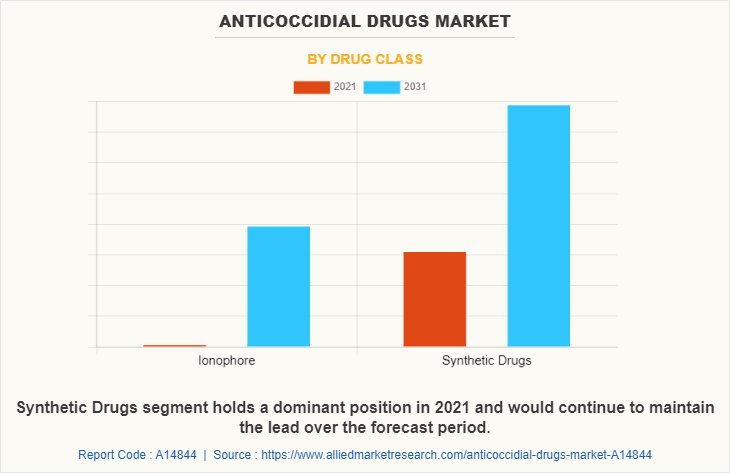
By drug action, the market is classified into coccidiostatic and coccidiocidal. The coccidiostatic segment accounted for the major Anticoccidial Drugs Market Size of the market in 2021 and is anticipated to continue this trend throughout the forecast period, owing to surge in the adoption of drugs with coccidiostatic mode of action and rise in number of research and development activities for the development of coccidiostatic medicines. Moreover, rise in preference of the anticoccidiosis drugs for the treatment of the disease also helps in growth of the market.
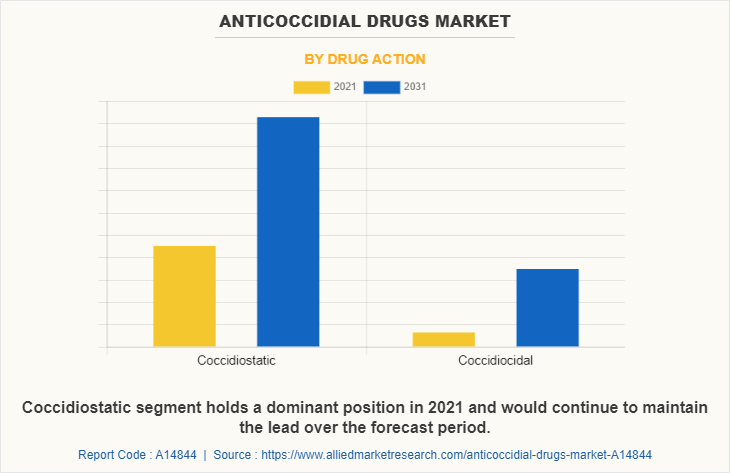
By animal type, the market is classified into poultry, cattle and others. The others segment accounted for the major Anticoccidial Drugs Market Sizeof the market in 2021 and is anticipated to continue this trend throughout the forecast period, owing to surge in number of swine population and pet animals population globally, which is mainly due to increase in demand of pet animals.
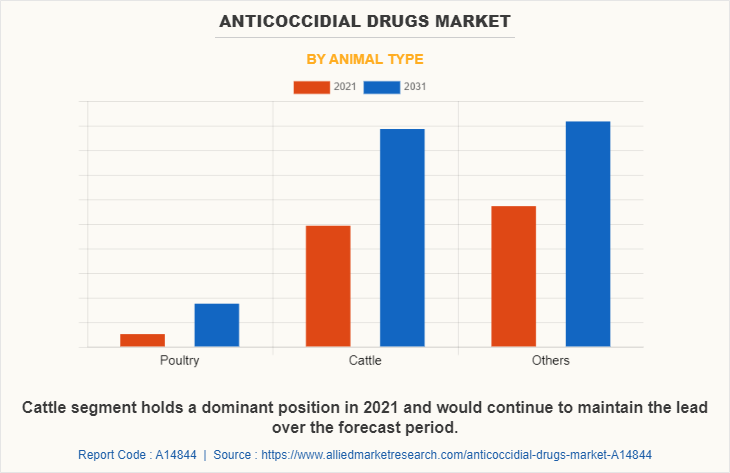
North America was the dominant region in the year 2021 and is expected to remain dominant throughout the Anticoccidial Drugs Market Forecast period, owing to high prevalence rate of coccidiosis, increase in the number market players and surge in the number of meat producers population in the region. However, Asia-Pacific is expected to witness the highest CAGR during the analysis period, owing to the presence of high populace countries such as India and China, which in turn increases the prevalence rate of coccidiosis disease, and the increasing number of strategies and trends adopted by the market players.
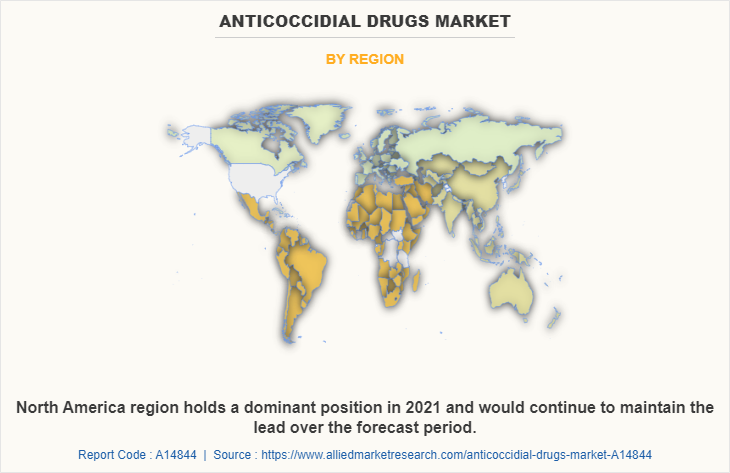
The key market players operating in this market include Bayer AG, Boehringer Ingelheim International GmbH, Ceva sante animale, Dosh Pharmaceuticals Private Limited, Huvepharma EOOD, Merck & Co., Inc., Venkateshwara hatcheries Private Limited, Vetoquinol SA, Virbac SA, Zoetis Inc.
Key Benefits For Stakeholders
- This report provides a quantitative analysis of the market segments, current trends, estimations, and dynamics of the anticoccidial drugs market analysis from 2021 to 2031 to identify the prevailing Anticoccidial Drugs Market Opportunity.
- The market research is offered along with information related to key drivers, restraints, and opportunities.
- Porter's five forces analysis highlights the potency of buyers and suppliers to enable stakeholders make profit-oriented business decisions and strengthen their supplier-buyer network.
- In-depth analysis of the anticoccidial drugs market segmentation assists to determine the prevailing market opportunities.
- Major countries in each region are mapped according to their revenue contribution to the global market.
- Market player positioning facilitates benchmarking and provides a clear understanding of the present position of the market players.
- The report includes the analysis of the regional as well as global anticoccidial drugs market trends, key players, market segments, application areas, and market growth strategies.
Anticoccidial Drugs Market Report Highlights
| Aspects | Details |
| Market Size By 2031 | USD 257.8 million |
| Growth Rate | CAGR of 4.2% |
| Forecast period | 2021 - 2031 |
| Report Pages | 220 |
| By Drug Class |
|
| By Drug Action |
|
| By Animal Type |
|
| By Region |
|
| Key Market Players | Bayer AG, Huvepharma EOOD, Dosh Pharmaceuticals, Merck & Co., Inc, Venkateshwara hatcheries Private Limited, Vetoquinol SA, Ceva sante animale, boehringer ingelheim animal health - us, Zoetis Inc, Virbac SA |
Analyst Review
In accordance to several the interviews conducted, coccidiosis is generally self-limited and most healthy puppies and kittens resolves clinically without therapy. However, administration of treatment can speed resolution of disease and may lessen environmental contamination and the potential for infecting other in contact animals.
Asia-Pacific is expected to witness the highest CAGR during the analysis period, owing to the presence of high populace countries such as India and China, which in turn increases the prevalence rate of coccidiosis, increase in awareness about control & prevention of coccidiosis and increase in government support on healthcare of veterinary population and other trends adopted by the market players.
The top companies that hold the market share in anticoccidial drugs market are Bayer AG, Boehringer Ingelheim International GmbH, Ceva sante animale, Dosh Pharmaceuticals Private Limited, Huvepharma EOOD, Merck & Co., Inc., Venkateshwara hatcheries Private Limited, Vetoquinol SA, Virbac SA, Zoetis Inc.
North America is the largest regional market for Anticoccidial Drugs.
The forecast period in the report is from 2022 to 2031
The market value of the anticoccidial drugs market in 2022 was $178.01 million.
The total market value of the anticoccidial drugs market is $171.25 million in 2021.
The base year for the report is 2021.
Yes, anticoccidial drugs companies are profiled in the report.
The key trends in the anticoccidial drugs market are by an growth in the animal industry, advancements in the anticoccidial treatment and R&D in the anticoccidial drugs treatment.
Loading Table Of Content...



